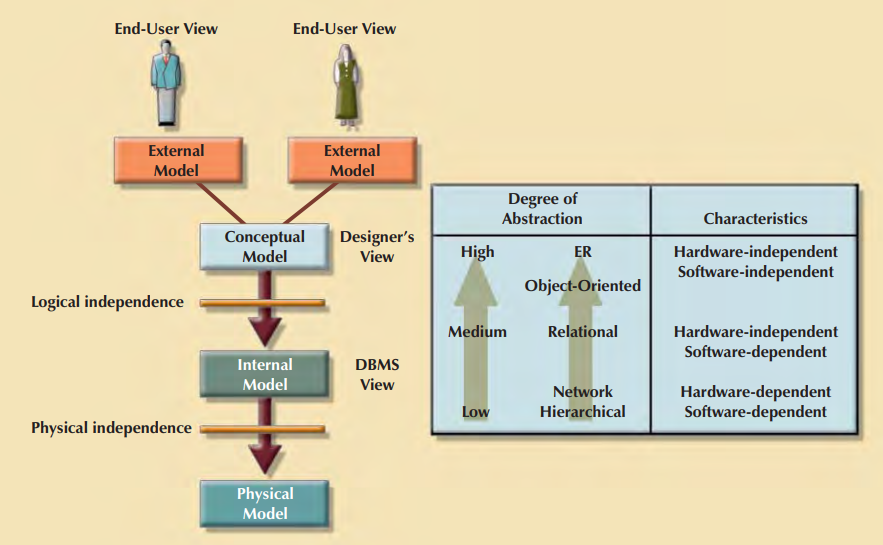In the early 1970s, the American National Standards Institute (ANSI) Standards Planning and Requirements Committee (SPARC) defined a framework for data modeling based on degrees of data abstraction. The ANSI/SPARC architecture (as it is often referred to) defines three levels of data abstraction: external, conceptual, and internal. You can use this framework to better understand database models
The External Model
The external model is the end users’ view of the data environment. The term end users refers to people who use the application programs to manipulate the data and generate information. End users usually operate in an environment in which an application has a specific business unit focus. Companies are generally divided into several business units, such as sales, finance, and marketing. Each business unit is subject to specific constraints and requirements, and each one uses a data subset of the overall data in the organization. Therefore, end users working within those business units view their data subsets as separate from or external to other units within the organization.

- A PROFESSOR may teach many CLASSes, and each CLASS is taught by only one PROFESSOR; that is, there is a 1:M relationship between PROFESSOR and CLASS.
- A CLASS may ENROLL many students, and each student may ENROLL in many CLASSes, thus creating an M:N relationship between STUDENT and CLASS.
- Each COURSE may generate many CLASSes, but each CLASS references a single COURSE. For example, there may be several classes (sections) of a database course having a course code of CIS-420. One of those classes might be offered on MWF from 8:00 a.m. to 8:50 a.m., another might be offered on MWF from 1:00 p.m. to 1:50 p.m., while a third might be offered on Thursdays from 6:00 p.m. to 8:40 p.m. Yet all three classes have the course code CIS-420
- Finally, a CLASS requires one ROOM, but a ROOM may be scheduled for many CLASSes. That is, each classroom may be used for several classes: one at 9:00 a.m., one at 11:00 a.m., and one at 1 p.m., for example. In other words, there is a 1:M relationship between ROOM and CLASS.
The Conceptual Model
Having identified the external views, a conceptual model is used, graphically represented by an ERD , to integrate all external views into a single view. The conceptual model represents a global view of the entire database as viewed by the entire organization. That is, the conceptual model integrates all external views (entities, relationships, constraints, and processes) into a single global view of the data in the enterprise. Also known as a conceptual schema, it is the basis for the identification and high-level description of the main data objects
Second, the conceptual model is independent of both software and hardware. Software independence means that the model does not depend on the DBMS software used to implement the model. Hardware independence means that the model does not depend on the hardware used in the implementation of the model. Therefore, changes in either the hardware or the DBMS software will have no effect on the database design at the conceptual level. Generally, the term logical design is used to refer to the task of creating a conceptual data model that could be implemented in any DBMS.\

The Internal Model
Once a specific DBMS has been selected, the internal model maps the conceptual model to the DBMS. The internal model is the representation of the database as “seen” by the DBMS. In other words, the internal model requires the designer to match the conceptual model’s characteristics and constraints to those of the selected implementation model. An internal schema depicts a specific representation of an internal model, using the database constructs supported by the chosen database
The development of a detailed internal model is especially important to database designers who work with hierarchical or network models because those models require very precise specification of data storage location and data access paths. In contrast, the relational model requires less detail in its internal model because most RDBMSs handle data access path definition transparently; that is, the designer need not be aware of the data access path details. Nevertheless, even relational database software usually requires data storage location specification, especially in a mainframe environment. For example, DB2 requires that you specify the data storage group, the location of the database within the storage group, and the location of the tables within the database.
The Physical Model
The physical model operates at the lowest level of abstraction, describing the way data are saved on storage media such as disks or tapes. The physical model requires the definition of both the physical storage devices and the (physical) access methods required to reach the data within those storage devices, making it both software- and hardware dependent. The storage structures used are dependent on the software (the DBMS and the operating system) and on the type of storage devices that the computer can handle. The precision required in the physical model’s definition demands that database designers who work at this level have a detailed knowledge of the hardware and software used to implement the database design
Although the relational model does not require the designer to be concerned about the data’s physical storage characteristics, the implementation of a relational model may require physical-level fine-tuning for increased performance. Fine-tuning is especially important when very large databases are installed in a mainframe environment. Yet even such performance fine-tuning at the physical level does not require knowledge of physical data storage characteristics
